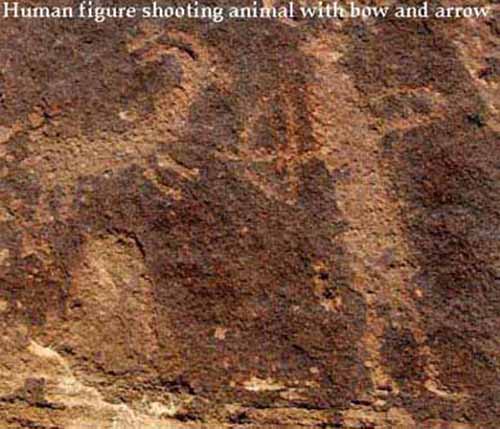
Range Creek area southeast of East Carbon City, Utah Archaeologists led reporters into a remote canyon to reveal an almost perfectly preserved picture of ancient life: stone pit houses, granaries and a bounty of artifacts kept secret for more than a half-century. Hundreds of sites on a private ranch turned over to the state offer some of the best evidence of the little-understood Fremont culture, hunter-gatherers and farmers who lived mostly within the present-day borders of Utah. The sites at Range Creek may be up to 4,500 years old.
A caravan of news organizations traveled for two hours from the mining town of East Carbon City, over a serpentine thriller of a dirt road that topped an 8,200-foot mountain before dropping into the narrow canyon in Utah's Book Cliffs region. Officials kept known burial sites and human remains out of view of reporters and cameras, but within a single square mile of verdant meadows, archaeologists showed off one village site and said there were five more, where arrowheads, pottery shards and other artifacts can still be found lying on the ground. Archaeologists said the occupation sites, which include granaries full of grass seed and corn, offer an unspoiled slice of life of the ancestors of modern American Indian tribes. The settlements are scattered along 12 miles of Range Creek and up side canyons.
The collapsing half-buried houses don't have the grandeur of New Mexico's Chaco Canyon or Colorado's Mesa Verde, where overhanging cliffs shelter stacked stone houses. But they are remarkable in that they hold a treasure of information about the Fremont culture that has been untouched by looters. The Fremont people were efficient hunters, taking down deer, elk, bison and small game and leaving behind piles of animal bone waste, Jones said. They fished for trout in Range Creek, using a hook and line or weirs. In their more advanced stage they grew corn.
Waldo Wilcox, the rancher who sold the land and returned Wednesday, kept the archaeological sites a closely guarded secret for more than 50 years. The San Francisco-based Trust for Public Land bought Wilcox's 4,200-acre ranch for $2.5 million. The conservation group transferred the ranch to the Bureau of Land Management, which turned it over to Utah. The deal calls for the ranch to be opened for public access, a subject certain to raise debate over the proper stewardship of a significant archaeological find.

Artifacts found in the Wilcox collection include a wide array of bone needles, stone awls, bone and shell beads, projectile points, knives, scrapers and other stone tools from an interesting variety of cherts,-- obsidian, pink agate and what resembled Llano Estacado alibate.
Fremont People
Petroglyphs
Reconstructed Pithouse - State Park, Boulder, Utah
The Fremont culture or Fremont people, named by Noel Morss of Harvard's Peabody Museum after the Fremont River in Utah, is an archaeological culture that inhabited what is now Utah and parts of eastern Nevada, southern Idaho, southern Wyoming, and eastern Colorado between about 400 and 1300 AD.
The Fremont culture unit was characterised by small, scattered communities that subsisted primarily through maize cultivation. Archaeologists have long debated whether the Fremont were a local Archaic population that adopted village-dwelling life from the neighboring Anasazi culture to the south, or whether they represent an actual migration of Basketmakers (the earliest culture stage in the Anasazi Culture) into the northern American Southwest or the area that Julian Steward once called the "Northern Periphery".
The Fremont have some unique material culture traits that mark them as a distinct and identifiable archaeological culture unit, and recent mtDNA data indicate they are a biologically distinct population, separate from the Basketmaker. What early archaeologists such as Morss or Marie Wormington used to define the Fremont was their distinctive pottery, particularly vessel forms, incised and applique decorations, and unique leather moccasins. However, their house forms and overall technology are virtually indistinguishable from the Anasazi. Their habitations were initially circular pit-houses but they began to adopt rectangular stone-built pueblo homes above ground.
Marwitt (1970) defined local or geographic variations within the Fremont culture area based largely on differences in ceramic production and geography. Marwitt's subdivisions are the Parowan Fremont in southwestern Utah, the Sevier Fremont in west central Utah and eastern Nevada, the Great Salt Lake Fremont stretching between the Great Salt Lake and the Snake River in southern Idaho, Uinta Fremont in northeastern Utah, and arguably the San Rafael Fremont in eastern Utah and western Colorado. (The latter geographic variant may well be indivisible from the San Juan Anasazi.)


5 comments:
ooh what can i say Egyt has make Africans proud and great.... so in this, we the Africans will say we are not in the world but the world is in Africa
ooh what can i say...? Egyt has make Africans proud and great.... so in this, we the Africans will say we are not in the world but the world is in Africa
Egyptian art is definitely one of my favorite art styles. It is really impressive what this civilization accomplished.
Post a Comment